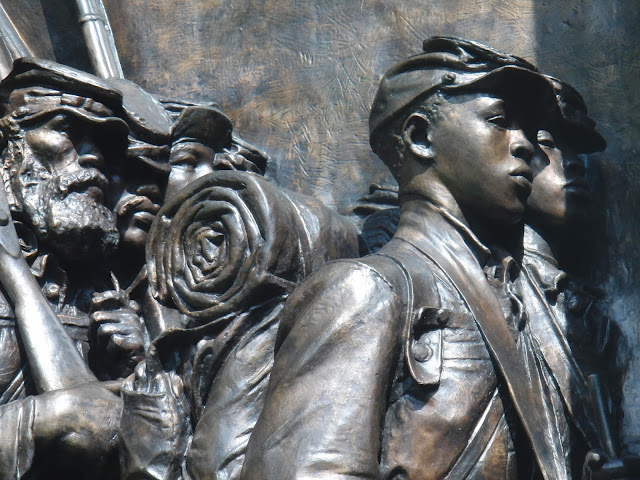The Massachusetts 54th fought with distinction and tenacity at Fort Wagner in South Carolina, losing 285 men, including Shaw. As a result of their courage, President Lincoln and the Congress formed more all African units. By the end of the war, the Union Army was 10% Black.
The creation of the Memorial began with the initiative of an African American businessman and Massachusetts legislator Joshua Benton Smith who grew up in the Shaw household as a family servant. Smith joined a committee of 21 prominent Bostonians tasked with erecting a monument to Shaw and the Massachusetts 54th. After much discussion, the committee decided to hire the famous sculptor Augustus Saint Gaudens to make the Memorial.
The Memorial is the masterpiece of Augustus Saint Gaudens who spent fourteen years making it from the time he received the commission in 1883 to the monument's unveiling in 1897.
Saint Gaudens originally intended to make a free standing equestrian statue of Colonel Shaw alone; however Shaw's family insisted that his men be commemorated with him. After the Battle of Fort Wagner, Confederate soldiers threw Shaw's body unceremoniously into a ditch with the bodies of his men. The rebel soldiers' intended insult became a great honor in the eyes of Shaw's family.
Saint Gaudens decided to make a large relief sculpture inspired precedents in ancient Roman art and in 19th century official French history painting, in particular Charles Meissonier's Campagne de France 1814 which he had seen in Paris. As only Saint Gaudens could, he combined a very Classical allegorical format with scrupulous realism.
A grieving spiritual figure in low relief, perhaps a personification of patriotism, hovers over the men shown as they might have actually appeared on the very spot in Beacon Street in May, 1863 when they officially departed for South Carolina. Among those on the reviewing stand that day were Governor John A. Andrew who ordered the formation of the unit, and Frederick Douglass whose two sons Lewis and Charles marched past in the regiment.
Saint Gaudens added above the marching soldiers and next to the allegorical figure this Latin inscription: OMNIA RELINQVIT/ SERVARE REPVBLICAM ("He gave up all to serve the Republic").
Saint Gaudens made great efforts to portray the soldiers realistically, and to avoid the common stereotypes prevalent in so much 19th century art. Each soldier is carefully individualized. All wear a grave and resolute expression.
Saint Gaudens hired numerous African American men to sit for about 40 portrait studies for the soliders. He also borrowed Civil War uniforms and insignia to make the soldiers as authentic as possible.
On the back of the Memorial is an inscription written by the President of Harvard University, Charles W. Eliot.
Soldiers of the Massachusetts 54th, all former slaves.
William Harvey Carney in 1864 with the flag of the Massachusetts 54th that he saved in the course of the battle for Fort Wagner. Carney became the first African American soldier to be awarded the Congressional Medal of Honor for his bravery. He was present at the unveiling of Saint Gauden's sculpture in 1897.
Henry Augustus Monroe at 13 years old was the regiment's drummer. His drum beats communicated the commanding orders to the soldiers in the heat of battle. He wrote a vivid account of the battle at Fort Wagner and later pursued a career as a teacher and a Methodist minister.
Robert Gould Shaw
Fort Wagner, a battery formation on a beach in South Carolina as it appeared in 1863.
The dedication ceremony for the Memorial in 1897.
One of Saint Gauden's compositional studies for the Memorial.
Augustus Saint Gaudens
The Shaw Memorial has been vandalized a number of times. In 2012, someone threw yellow paint on the monument. On other occasions, vandals tried to steal Colonel Shaw's sword damaging the sculpture.
I expect this monument to be even more of an object of controversy in coming days.



















3 comments:
Doug, thank you for this whole series of posts since Charlottesville. The images and the story of the Shaw memorial are so moving. The faces of the soldiers just knocked me out.
Thanks! It was all my pleasure.
Vandalizing this? Disgraceful! The end of "Glory" when they run the credits over this monument: makes me bawl like a baby (I'm tearing up as I type this).
Post a Comment